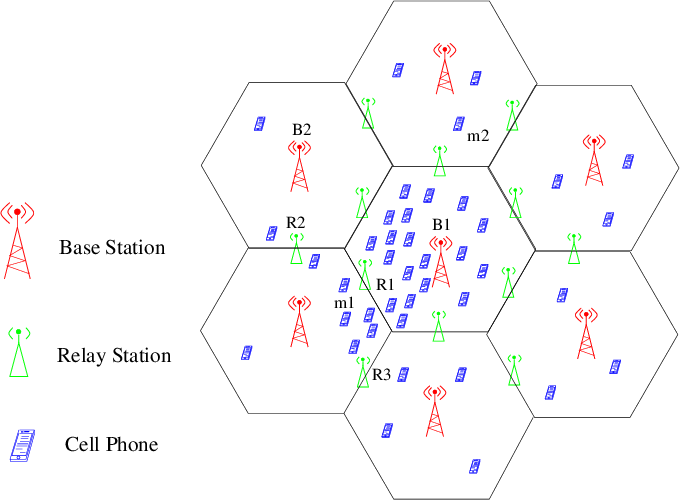GSM AND GPRS
Welcome to the blog of GSM and GPRS

Cellular Networks
What is a cellular network, July 16, 2021
A Cellular Network or Mobile Network is a communication network where the link to and from end nodes is wireless. The network is distributed over land areas called "cells", each served by at least one fixed-location transceiver (typically three cell sites or base transceiver stations).
These base stations provide the cell with the network coverage which can be used for transmission of voice, data, and other types of content. A cell typically uses a different set of frequencies from neighboring cells, to avoid interference and provide guaranteed service quality within each cell.
The first commercial cellular network, the 1G generation, was launched in Japan by Nippon Telegraph and Telephone (NTT) in 1979. It was an analog wireless network.
The first commercial digital cellular network, the 2G generation, was launched in 1991. This sparked competition in the sector as the new operators challenged the incumbent 1G analog network operators.
Signal encoding is required to differentiate/distinguish signals from several differenttransmitters. The following cell signal encoding techniques were developed for this purpose:
- FDMA (Frequency Division Multiple Access) - used by analog systems and D-AMP(Digital Advanced mobile Phone System).
- TDMA (Time Division Multiple Access) - used by GSM.
- CDMA (Code Division Multiple Access) - first used for PCS(Personal Communications Service) and the basis for 3G.
There are a number of different digital cellular technologies including:
- Global System for Mobile Communications (GSM)
- General Packet Radio Service (GPRS)
- cdmaOne (IS-95 (Interim Standard 95))
- CDMA2000
- Evolution-Data Optimized (EV-DO)
- Enhanced Data Rates for GSM Evolution (EDGE)
- Universal Mobile Telecommunications System (UMTS)
- Digital Enhanced Cordless Telecommunications (DECT)
- Digital AMPS (IS-136/TDMA)
- Integrated Digital Enhanced Network (iDEN)

GSM
What is GSM, July 16, 2021
GSM (Global Systems for Mobile Communication) is a standard developed by the European Telecommunications Standards Institute (ETSI) to describe the protocols for second-generation (2G) digital cellular networks used by mobile devices such as mobile phones and tablets.
2G networks developed as a replacement for first generation (1G) analog cellular networks. The GSM standard originally described a digital, circuit-switched network optimized for full duplex voice telephony.
GSM uses a variation of time division multiple access (TDMA) and is the most widely used of the digital wireless telephony technologies.
Short Messaging System (SMS) was introduced into GSM networks along with capability to download content from various service providers.

GPRS
What is GPRS, July 16, 2021
GPRS (General Packet Radio Service) is a packet oriented mobile data standard on the 2G and 3G cellular communication network's global system for mobile communications (GSM). GPRS was established by European Telecommunications Standards Institute (ETSI).
2G cellular technology combined with GPRS is sometimes described as 2.5G, that is, a technology between the second (2G) and third (3G) generations of mobile telephony.
GPRS extends the GSM Packet circuit switched data capabilities and makes the following services possible:
- SMS messaging and broadcasting
- "Always on" internet access
- Multimedia messaging service (MMS)
- Push-to-talk over cellular (PoC)
- Internet applications for smart devices through wireless application protocol (WAP)
- Point-to-point (P2P) service: inter-networking with the Internet (IP)
- Point-to-multipoint (P2M) service: point-to-multipoint multicast and point-to-multipoint group calls
GPRS is a packet-switching network, and its billing is normally according to the total volume of data transferred. In contrary, GSM which is a circuit-switching network has the billing done per minute (or third of a minute) of connection time.

Cell Phone Call Routing
How cell phone calls are routed, July 16, 2021
When we switch on the mobile phone, it tries for an SID (System Identification Number - unique 5 digit number that is assigned to each carrier by the FCC) on the Control channel. The Control channel is a special frequency that the phone and base station use to talk to one another. If the Mobile phone finds difficulty to get link with the control channel, it displays a “no service” message.
If the Mobile phone gets the SID, it compares the SID with the SID programmed in the phone. If both SID match, the phone identifies that the cell it is communicating is the part of its home system.
The phone also transmits a registration request along with the SID and the MTSO (Mobile Telephone Switching Office) keeps track of your phone’s location in a database. MTSO knows in which cell you are when it wants to ring the phone.
When the MTSO then gets the signal (a call is made), it tries to find the phone. The MTSO looks in its database to find the cell in which the phone is present. The MTSO then picks a frequency pair to take the call.
The MTSO communicates with the Mobile phone over the control channel to tell it what frequencies to use. Once the Mobile phone and the tower switch on those frequencies, the call is connected.
When the Mobile phone move toward the edge of the cell, the cell’s base station will note that the signal strength is diminishing. At the same time, the base station in the cell in which the phone is moving will be able to see the phone’s signal strength increasing.
The two base stations coordinate themselves through the MTSO. At some point, the Mobile phone gets a signal on a control channel and directs it to change frequencies. This will switch the phone to the new cell.




